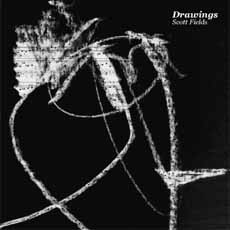
drawings
Scott Fields
cs130
Thomas Hornung,
a German artist, lives in two small rooms at the edge of town in Basel,
Switzerland. Each of the two rooms, which are separated by a hallway on
the second floor
of a house near a café, are configured identically, with a single
bed, a dresser, a nightstand,
and a drawing table. Like his rooms, Thomas’s days are uniform,
a routine of coffee in the
café, a trip to the grocery around the corner for bread and a bottle
of wine, and a spell
reading the newspaper on his balcony. Near dusk Thomas smokes a joint
on his balcony,
opens the bottle of wine, puts a cello recording — usually the Dvorak
concerto — on
his ministereo and begins to draw. He works on A4 paper, typically in
black but occasionally in
colored chalk. A drawing rarely takes longer than a minute to complete.
After each handful
of drawings Thomas takes a short break, sipping wine and smoking a cigarette.
After a hour
or so he is done drawing for the night. He then reviews each of the twenty
to thirty pieces
he has finished. Those he finds acceptable he adds to his archive. Rejects
are torn to small
pieces.
Four years ago, in 2004, I attended an artists residency in the Swiss
Alps. It was a strange
place, housed in a former heath spa that squats next to a river and above
an aquifer that
supplies four types of allegedly healing, undeniably vile-tasting, waters.
It was here that I
met Thomas, who earlier had been an artist-in-residence and was by then
on staff. Another
resident was visual and video artist Arno Oehri. Arno and I were intrigued
by Thomas’s art
and his way of working. Each of us wanted to somehow incorporate his drawings
into a
project of our own. Soon we decided to combine our projects, although
it wasn’t clear how.
Eventually I decided to convert some (as it turned out 171) of his drawings
into a multi-page
graphic score. To do that I made a matrix of pitch rows and numbers that
represent playing
techniques. Then I reversed Thomas’s drawings so that what was black
became transparent.
Finally I laid each drawing over the matrix and used what was visible
as an element in an
extended, modular composition. In concert I shuffle the score’s
171 pages and play through
them at the rate of about 50 a set.
In Cologne, at The Loft, a performance space that also serves as a recording
studio, I shuffled
the scores and recorded each one until I had an acceptable version, setting
the others aside
to simulate Thomas’s custom of tearing up his rejects. The idea
was for each take to reflect
the amount of time Thomas took to make that drawing. The denser his drawing,
the longer
I played. Some takes were as short as seven seconds and the longest were
not much longer
than a minute. At the end of a non-stop, six-hour session I had 254 takes,
171 of which I kept.
Thomas sometimes reviews his archive and tears up drawings that no longer
please him.
Similary, a month later I culled the 171 acceptable takes down to 99,
one for each track possible
on the CD. (For this release, I merged segments 98 and 99 to liberate
an index mark for
the video).
Arno’s project was a multi-media installation in the Kunstmuseum
Liechtenstein. At the center
of the large installation space was a smaller room the size of Thomas’s
room. On the walls
were pinned 99 drawings that were the basis of the 99 tracks on this CD.
Along one side of
the small room’s exterior were tables that supported five listening
stations loaded with this
CD, copies of the score, and three monitors playing Arno’s documentary
videos. These
documentaries included interviews with Thomas and myself, shots of two
evenings in Thomas’s
room in Basel during which I improvised on guitar while he drew, shots
of Thomas working,
and shots of the recording session at The Loft. Along the other side of
the room was a large
projection of Arno’s 301 Miniaturen, about which he says:
“301 short sequences generated from the raw materials of the documentaries
for the installation
The Room. The sequences are in slow motion and last between 6 to 25 seconds,
corresponding
to the duration of the realization of a drawing by Thomas Hornung and
the duration of Scott
Fields’ music pieces. The slow down of the videos counteracts the
hectic and short work process
of the other two artists, allowing some deeper insight into the gestures
and conditions of their
respective working ambiance, and offers it a poetic and atmospheric concentration
of the
two-year collaboration of the three artists involved. The soundtrack of
this video is based on
an extreme slow motion of some fragments of Scott Fields’ Drawings
and becomes perceptible
as an unidentifiable murmur in the space.”
Scott Fields 2008